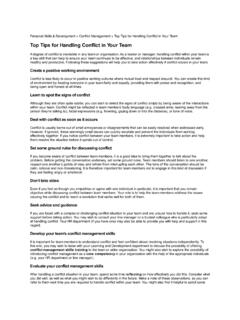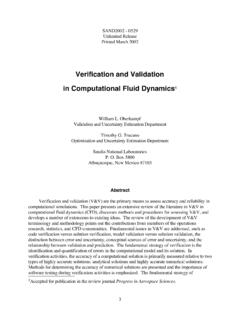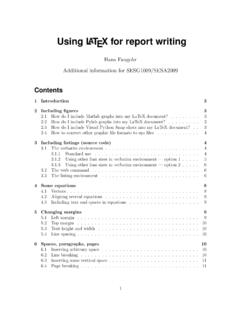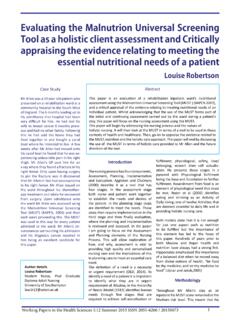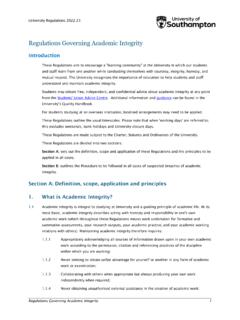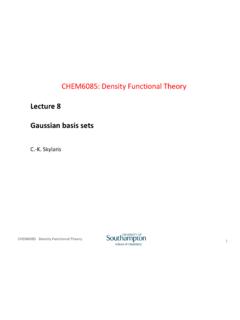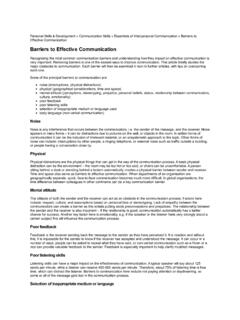Transcription of MATH6011: Forecasting - University of Southampton
1 IMATH6011: Forecasting All models are wrong, but some models are useful. George E. P. Box (1919 2013)About the courseAs stated in the module profile, the aim of this course is to (1) introduce the students to timeseries models and associated Forecasting methods; (2) show how such models and methods can beimplemented on a spreadsheet to analyse time series data; (3) give an appreciation of the differentfields of application of time series analysis and Forecasting ; and (4) convey the value of suchquantitatively based methods for solving realistic practical problems. Students who completethe module successfully should be able to (a) formulate time series models and construct Excelspreadsheet-based versions; (b) use spreadsheet techniques to fit and analyse such models to data;(c) appreciate both the capabilities and the limitations of such computer based techniques; and (d)produce well-structured assignment reports describing problem formulation and is no pre-requisite for the module, but students who have taken MATH6147 (Spreadsheetand Database Modelling) and MATH6005 (Visual Basic for Applications) will find the Excelimplementations of the models relatively easy.
2 The material for these modules will be madeavailable on the Blackboard site of this course. This will allow those of you who are interested tolook at them for further details on Excel (MATH6147) or VBA (MATH6005) to go through themand possibly learn how to develop their own VBA codes for the algorithms that will be discussedin the course. Further links and sites for quick references on these tools are also provided on theblackboard site. Note however that for this course and the related assessment, no programmingskill is required and all the basic tools needed to succeed are provided. It might also be useful tomention that it would be an advantage to have taken a basic course on statistics. Most of the usefulconcepts will be recalled, and further details can be found in any basic book on Statistics, see, ,Clarke, and Cooke, D.
3 2004, A basic course in statistics, 5th Ed., module usesMakridakis, S., Wheelwright, and Hyndman, 1998, Forecasting :Methods and Applications 3rd Ed., New York: Wileyas text book. Most of the material of thesenotes is extracted from there. Also, most of the data sets used in the demonstrations is drawn fromthis book. (The full set from the book can also be downloaded under Course Documents, if desired.)Hyndman, and Athanasopoulos, G. 2014. Forecasting : principles and practice. recently superseded the latter book. Hence, some of the material of these notes has also beendrawn from there. An additional advantage of the book by Hyndman and Athanasopoulos (2014) isivthat it is freely accessible to read online (at ). A few hard copies of thebook can be found at the Hartley Library.
4 Other interesting references , , Sweeney, and Williams, 1994. An Introduction to ManagementScience. 7th Edn, West Publishing Co.; , and Smith, H. 1981. Applied Regression Analysis, 2nd Ed. New York: Wiley;3. Gilchrist, 1976. Statistical Forecasting , New York: Wiley;4. Janert, 2011. Data Analysis with Open Source Tools. Sebastopol: O Reilly;5. Wetherill, 1981. intermediate Statistical Methods. London: Chapman and notes and spreadsheets used in the module are available on the course Blackboard site underCourse Documents, where the spreadsheets are grouped by chapter and workshop, notes are meant to be worked through and each chapter is accompanied by a number ofdemos associated to the spreadsheets, illustrating the topic or method being discussed.
5 They arean essential part of the text and must be carefully studied, possibly before the lectures. In thespreadsheets, the following convention for cells is used: Cells with a Yellow background - Headings, incidental Information; Cells with a Green background - Input information used in calculations on that sheet; Cells with a Blue background - Calculations and results that you should be included at the end of each chapter correspond to the worksheet for the workshop ofthe corresponding week. They will be worked through during the workshops (computer labs) thatfollow the Friday lecture. The workshop exercises follow the same patterns as the demos, and usethe same data sets in some cases, in order to give you the opportunity to get more familiar with therelated material, as focus at lectures will be more on the mathematical aspects of the : The assessment of the module is 100% by a single coursework assignment.
6 Youwill be given the assignment and related instructions in the second week. Further details on thesubmission and other key dates of the module activities are given in the table on the next : A key opportunity to get feedback on your progress in the module will be during theweekly workshops. To benefit the most from the workshops, you are strongly encouraged to workon the problem sheets in advance before coming to the workshop. This will help us access whereyou are struggling and provide immediate help. It is also the best way for you to get well preparedfor the exercises in your coursework assignment. You are also encouraged to come to my officehours to discuss any particular aspect of the lectures/material you might be struggling to appointment is needed to come to my office hour.
7 I will be able to provide some brief elementof feedback by email (efforts will be made to reply by the next working day after reception) if youhave any quick questions. I have also arranged three voluntary sessions (assignment surgeries),prior to the coursework submission deadline, where you could ask questions and get feedback onthe module and the coursework preparations; see next page for the dates. The final feedback onyour performance on the coursework will be provided within 4 weeks after the submission : Dr Honora Smith and Prof Russell Cheng are gratefully acknowledgedfor the development of previous drafts of the course notes and the related Alain ZemkohoSchool of MathematicsBuilding 54, Room Teaching Assistantsa: Zulkipli HafizahBinti, Fulin Xie and Yuan ZhangaThey will join me during the workshops to helpwith your questions on the exercises.
8 Please do notcontact them for any assistance related to the course-work and basic tools.. and numerical summaries .. data summaries .. estimation using moving averages .. decomposition .. decomposition .. and Forecasting .. of the times series .. and erroneous data .. adjustments .. Forecasting methods.. of Accuracy .. of forecast error .. interval .. smoothing exponential smoothing .. s linear exponential smoothing .. s method .. implementation of the exponential smoothing method .. using regression.. model and key description .. the coefficients of the regression model .. statistics for model evaluation .. of explanatory variables to the initial model.
9 Related explanatory variables .. selection .. linear regression for made and the validity of tests and forecasts .. forecast .. ARIMA method.. partial autocorrelation function .. white noise model .. (AR) models .. Average (MA) models .. (p, d, q) models .. (p, d, q)(P,D,Q)smodels .. selection and 1: Identification .. 2: Parameters estimation and testing .. 3: Forecasting using the ARIMA model .. forecast .. Introduction and basic toolsMany companies make use of judgmental Forecasting techniques which rely on the knowledge ofexperienced employees and managers. Such aqualitativeapproach is common in the case wherethere is no historical data; for example, if one wants to forecast the sales of a new product.
10 A typicalsituation where judgemental Forecasting can also be crucial isBrexit. As there is no precedent tothis situation, it is almost impossible to accurately identify any historical factor that can be usedto make reliable predictions of its impact on the UK s economy. Often, qualitative forecastingis carried out within the framework of fairly formal and regularly scheduled meetings. It can beaugmented by the kind of quantitative techniques discussed in this unit, and this combined approachhas much to commend it. Further details on qualitative Forecasting methods can be found in Chapter3 of the book by Hyndman and Athanasopoulos (2014).Our focus in this course will be onquantitativeforecasting methods. A quantitative approachrelies on sufficient reliable quantitative information being available.


